In an English class,the teacher,firstly,plays the radio and asks students to listen to the tape and understand the dialogue.Then,the teacher asks students to read after the tape to imitate the pronunciation.Next,the teacher asks students to repeat the dia
题目
In an English class,the teacher,firstly,plays the radio and asks students to listen to the tape and understand the dialogue.Then,the teacher asks students to read after the tape to imitate the pronunciation.Next,the teacher asks students to repeat the dialogue in pairs...What teaching method does the teacher use in this class?
A.Communicative Approach.
B.Task-Based Teaching Approach.
C.The Audio-Lingual Approach.
D.The Audio-Visual Approach.
B.Task-Based Teaching Approach.
C.The Audio-Lingual Approach.
D.The Audio-Visual Approach.
相似考题
更多“In an English class,the teacher,firstly,plays the radio and asks students to listen to the tape and understand the dialogue.Then,the teacher asks students to read after the tape to imitate the pronun”相关问题
-
第1题:
When a teacher teaches young learners English pronunciation, he should__________.A.listen as much as possible
B.input regardless of students'ability
C.tolerate small errors in continuous speech
D.read more English materials答案:C解析:考查语音教学。教年轻的学习者英语发音,正确的做法之一就是要包容一些小错误,不要一错了就马上纠正。 -
第2题:
If a teacher asks students to collect, compare and analyze certain sentence patterns, he/sheaims at developing students′
A.discourse awareness
B.cultural awareness
C.strategic competence
D.linguistic competence答案:D解析:考查教师组织活动的意图。此题是问:如果老师让学生去收集、比较和分析某些句型.他/她旨在发展学生的________。A项意为“语篇意识”,B项意为“文化意识”,C项意为“策略能力”,D项意为“语言能力”。由题干可以看出,老师组织的活动主要是针对句型结构,进一步而言,实际体现的是对语言能力的训练。故选D。 -
第3题:
When a teacher asks the students to find some key words from a text quickly, he/she is intended to train students' __________strategy in reading class.A.skimming
B.scanning
C.extensive reading
D.intensive reading答案:B解析:考查阅读教学。scanning“寻读”,可以帮助学生快速找到所需信息,准确定位。故选B。skimming“读”,快速浏览文本,掌握文章大意。extensive reading"泛读”,是指进行广泛、大量的阅读.可以使学生通过频繁地接触语言材料,自觉或不自觉地学到或掌握大量词汇,开阔学生的视野。intensive reading"精读”.是指深入细致、逐字逐句地阅读,可以通过深入钻研.加深知识的积累,、 -
第4题:
If a teacher gives commands in English and asks students to show understanding by action_______or gestures, he/she is most probably usingA.Communicative Approach
B.Audio-Lingual Approach
C.Grammar Translation Method
D.Total Physical Response答案:D解析:考查全身反应法。全身反应法以“听一做动作”为主要教学组织形式。学习过程中.教师用目标语发出指令,先自己做,等学生能理解后,让学生完成动作,然后边说边做。故选D。 -
第5题:
In a listening class,the teacher asks students to write a broad outline according to their notes which are made during listening.Which stage does this activity belong to?A.Pre-listening
B.While-listening
C.Post-listening
D.Practice答案:C解析:考查听力教学过程
C选项,听后阶段是产出阶段,包括根据所听内容进行口头或笔头转述等活动。符合题意,故此题的正确选项为C。
A选项,听前阶段主要是针对激活背景知识,为听力做准备的阶段,此阶段活动包括:熟悉话题、预测大意等,故排除。
B选项,听中阶段是做听力理解的阶段,主要包括边听边选择、填空、做笔记等活动,故排除。
D选项,练习环节,不是PWP模式的环节,故排除。
故此题的正确选项为C。 -
第6题:
初中英语?语音
一、考题回顾
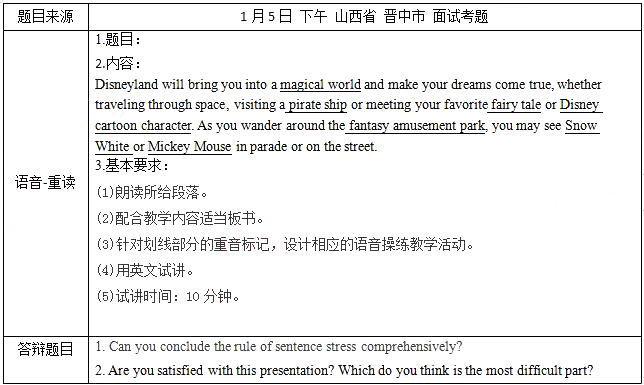
二、考题解析
【教案】
Teaching aims:
Knowledge aim:
Students will know the rule of logical stress in a complete sentence.
Ability aim:
Students will use the logical stress correctly and know how to make use of the sentence stress in different sentences correctly.
Emotional aim:
Students will be more confident in speaking English.
Key and difficult point:
Key Point: Students will master the rule of logical stress in sentences in English.
Difficult Point: Students can use the logical stress in sentences in daily life.
Teaching procedure:
Step 1: Warming-up
1. Greetings.
2. Listen to an English song and feel about the tune of the melody. Let students to know that not only songs but also the language has its stress in order to express different emotions.
Step 2: Presentation
1. Work in pairs to read the passage by themselves and ask them to pay more attention to the sentence stress. After practice, ask one pair to perform it and others should tell their opinion whether they agree or not.
2. Listen to the tape of the passage and find out whether the students themselves make any mistakes. Then let students find out the rule of the sentence stress (logical stress ) with the help of the teacher: in a sentence we can stress the important part according to the meaning of the passage. After the students find the rule, the teacher read the passage and let them repeat after it.
Step 3: Practice
1. Ask students to read the passage by themselves again and they should use the correct logical stress while reading.
2. Give students more sentences and ask them read the sentences by themselves using the logical stress.
Step4: Production
Let students work in groups of 4 and make a dialogue about the theme parks, such as the theme, the feature, the activities and so on, and they should use the rule of logical stress learned in the class. After that invite two groups to share their outcomes with the whole class.
Step5: Summary and Homework
Summary: ask a student to conclude the content of the lesson and summarize with the whole class.
Homework: ask students to read the work of Shakespeare’s and use the logical stress learned today after class.
Blackboard design:
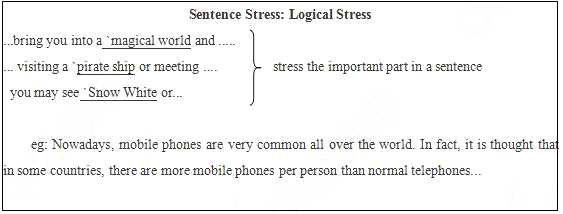
1. Can you conclude the rule of sentence stress comprehensively?
2. Are you satisfied with this presentation? Which do you think is the most difficult part?答案:解析:1.
As far as I’m concerned, there are two sentence stress rules: logical stress and grammatical stress. Logical stress is what i have presented in the presentation. The grammatical stress refers to that we need to stress notional word, which usually contains noun, verb, adjective adverb and so on. At the same time, the functional word needn’t to be stressed, which usually includes conjunction, article and preposition.
2.
The difficulty in my eyes is: first of all, without the participation of students, because of the teaching reasons, I can not interact effectively with students based on their feedback. In this case, it is difficult for me to organize classroom teaching activities and achieve the desired results. Second, what I need to improve is to introduce the key points to the students in a way that is easy to accept and adapt to the environment without an atmosphere of spoken English, because my spoken English is not very fluent, and I am very concerned about this interview. So I felt a little nervous. However, all these factors did not affect my overall performance. In view of the above problems, I will constantly reflect, and learn from experience in practice to improve my teaching ability. In short, I am basically satisfied with the presentation. -
第7题:
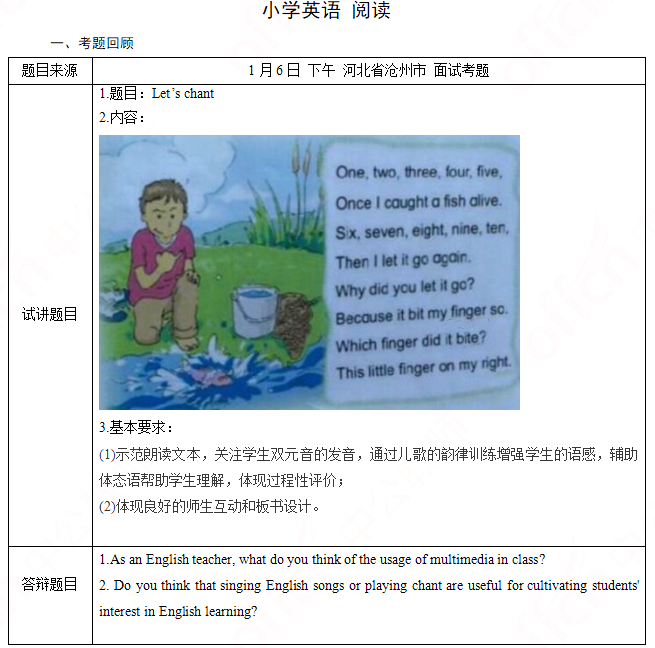
二、考题解析
【教案】
Teaching aims:
Knowledge aim:
Students will master the sound /ai/ in the words “five”, “alive” and so on.
Ability aim:
Students will apply the sound correctly in real communication.
Emotional aim:
Students will be more interest in speaking English.
Key and difficult point:
Key Point: Students will master the sound /ai/ in the words “five”, “alive” and so on.
Difficult Point: Students will apply the sound correctly in real communication.
Teaching procedure:
Step 1: Warming-up
1. Greetings.
2.Play a chant they have learned “tomato, tomato, wash, wash, wash” and lead them to learn another chant this class..
Step 2: Presentation
1. Students watch the picture and tell the teacher what they can see in the picture, and the teacher guide them to present the first part of the chant. Then students watch the picture carefully and predict what’s wrong with the boy, then the teacher guide them to present the last part of the chant.
2. Students observe the sentences and find out what common letters they can find.
3. The teacher teaches them correct pronunciation of the letter “i” in “five”, “right” and so on.
Step 3: Practice
1. Read the pronunciation /ai/ and the words that includes “i” repeatedly.
2. Listen to the tape and follow the tape, paying attention to the intonation of the chant.
3. Students work in pairs to make a chant in 5 minutes.
Step4: Production
1. The teacher writes more words that includes the sound /ai/and students try to read them.
2. Students work in groups to make a story using the picture and the words with the sound /ai/ on the blackboard.
Step5: Summary and Homework
Summary: ask a student to conclude the content of the lesson and summarize with the whole class.
Homework: ask students to search other pronunciation of the letter “i” and list those words accordingly.
Blackboard design:

1. As an English teacher, what do you think of the usage of multimedia in class?
2. Do you think that singing English songs or playing chant are useful for cultivating students' interest in English learning?答案:解析:1.
Multimedia help students to understand our class more smoothly and vividly and enhance their thinking ability. With images, audios and videos, knowledge that is difficult to understand in English is well presented. The students can more truly feel the content of the text, which is helpful to solve difficulties. In the environment of multimedia students can also develop abstract thinking and divergent thinking.
2.
As far as the activity such as singing or chant itself is concerned, it is very interesting and can attract students' attention. The time for students to keep concentrating is limited. If you add such activities as some songs and chants that students like, you can not only attract students' attention, but also cultivate their interest in learning. Therefore, combining knowledge and activities in the classroom allows students to learn while playing and even achieve better effects. -
第8题:
单选题The teacher asks students to do a group-work task . Before the task, the teacher assigns roles clearly around the class, pointing to each student in turn . "You are A . . . you are B . . ., etc ."Here the teacher plays the role of ______ .Acontroller
Bprompter
Cfacilitator
Dorganizer
正确答案: B解析: -
第9题:
单选题When a teacher asks students to brainstorm what they will write about an unforgettable trip, he/she mainly focuses on ________Aideas
Blayout
Cstyle
Dfeedback
正确答案: A解析: -
第10题:
单选题The teacher gives students 2 minutes to skim a text,and when time is up,he asks students to stop and answer some questions.Here the teacher is playing the role of a(n)_______.Aassessor
Bprompter
Cparticipant
Dcontroller
正确答案: C解析: -
第11题:
单选题What is being practised if a teacher asks students to read words like cot, hot and dog,log ?ASpelling and structure.
BStress and sound.
CMinimal pairs.
DPhonetic symbols.
正确答案: B解析: -
第12题:
单选题In a speaking class, the teacher asks students to work in pairs and create a new short play about asking ways. This activity belongs to _____.Awarming-up
Bpresentation
Cpractice
Dproduction
正确答案: B解析: -
第13题:
If a teacher gives commands in English and asks students to show understanding by action or gestures, he/she is most probably using__________.A.Communicative Approach
B.Audio-lingual Approach
C.Grammar Translation Method
D.Total Physical Response答案:D解析:考查英语教学法。全身反应法以“听一做动作”为主要教学组织形式。学习过程中,教师用目标语发出指令.先自己做,等学生能理解后,让学生完成动作,然后边说边做。故选D。 -
第14题:
In an English class, the teacher, firstly, plays the radio and asks students to listen to the tape and understand the dialogue. Then, the teacher asks students to read after the tape to imitate the pronunciation. Next, the teacher asks students to repeat the dialogue in pairs...What teaching method does the teacher use in this class?A.Communicative Approach.
B.Task-Based Teaching Approach.
C.The Audio-Lingual Approach.
D.The Audio-Visual Approach.答案:C解析:本题考查英语教学法
C选项,根据题干描述可知,这位老师采取的是“听音理解对话的含义——模仿——重复”这样一个教学过程,由此可知,该老师使用的是听说法。综上,C选项正确。
A选项,“交际法”,故排除。
B选项,“任务型教学法” ,故排除。
D选项,“视听法”,故排除。
故正确答案为 C 项。 -
第15题:
The teacher asks students to do a group-work task. Before the task, the teacher assigns roles clearly around the class, pointing to each student in turn."You are A ... you are B ..., etc."
Here the teacher plays the role of_______A.controller
B.prompter
C.facilitator
D.organizer答案:D解析:考查教师角色。教师在要求学生进行小组任务前,先给全班同学分配角色,这体现了教师的组织者角色。故选D。 -
第16题:
When a teacher asks the students to find some key words from a text quickly, be/she areintended to train students'_________ strategy in reading class.A.skimming
B.scanning
C.extensive reading
D.intensive reading答案:B解析:考查阅读教学。scanning“寻读”,可以帮助学生快速找到所需信息,准确定位。故答案选B。skimming“读”,快速浏览文本。掌握文章大意。extensive reading“泛读”,是指进行广泛、大量的阅读,可以使学生通过频繁地接触语言材料。自觉或不自觉地学到或掌握大量词汇,开阔学生的视野。intensive reading“精读”,是指深入细致、逐字逐句地阅读,可以通过深入钻研,加深知识的积累。 -
第17题:
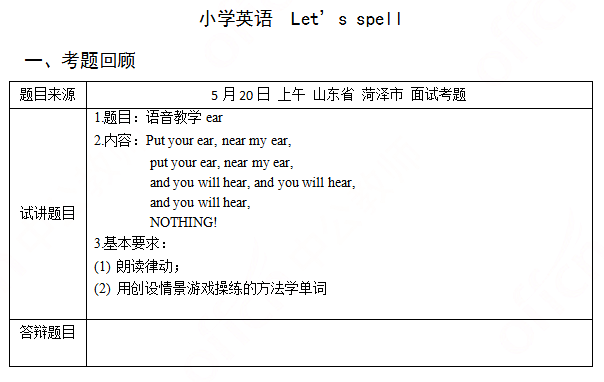
二、考题解析
【教案】
Teaching aims:
Knowledge aim: Students can understand the pronunciation of “ear”, and get some simple spelling rules.
Ability aim: Students can read the words with the pronunciation of “ear” correctly by listening and speaking. Ability of listening and speaking will be improved.
Emotional aim: Students can increase their interests in learning English.
Key and difficult point:
Key points: Students can understand the pronunciation of “ear”, and how how to read the words contain “ear”, such as hear, near and etc.
Difficult points: Students can master the pronunciation of “ear” and read the related words correctly.
Teaching procedure:
Step 1: Warming-up
Greeting the students.
Sing a song: Head shoulder keens and toes.
Step 2: Presentation
1. Show the chant and ask the students the question: Can you find the same letter combination in these words?
2. Listen to the tape and let students pay attention to the pronunciation of “ear”, and then ask the students question: what does “ear” sounds like in these words?
3. Teacher the pronunciation of “ear” ,and let students pay attention to the teacher’s mouth.
4. Game: Play the finger show to practice the new words.
Step 3: Practice
Find more words with “ear” such as tear, dear, clear... and ask students to try to read by themselves and then invite some of them to share with the class. The teacher should act the role of monitor.
Step4: Production
1. Ask students to make up their own sentences by using the words learned today, such as “He hears the bad news,and then his tears falls down. ”.
2. Reading competition: let students to read the chant as quickly as possible, and then let students choose the best one.
Step5: Summary and homework
1. Summary: ask students summary what have learned in the class.
2. Homework:
(1) read these word after class.
(2) Find more words with “ear” and make another chant.
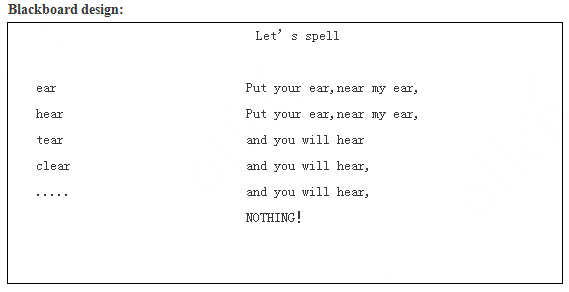 答案:解析:暂无解析
答案:解析:暂无解析 -
第18题:
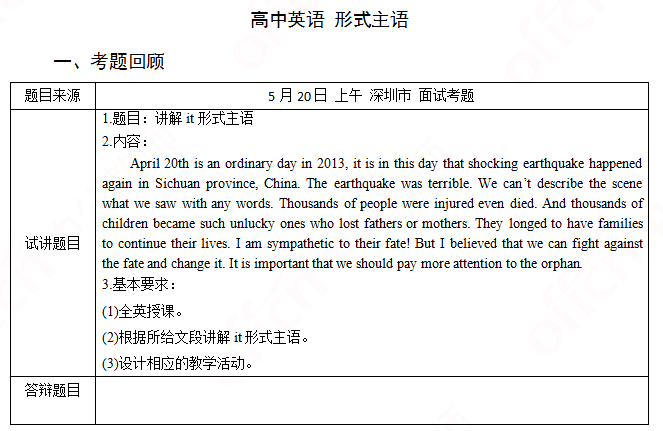
二、考题解析
【教案】
Teaching aims:
Knowledge aim: Students can master the usage of formal subject.
Ability aim: Students can use formal subject to communicate in their daily life.
Emotional aim: Students can enhance their interest in learning English.
Key and difficult point: Students can use formal subject to communicate in their daily life.
Teaching procedure:
Step 1: Warming-up
The teacher plays a documentary video about the earthquake in Wenchuan. Then asks students to talk about their feelings after watching. And lead in the topic.
Step 2: Presentation
The teacher lets students to read the passage and get the main idea. Then the teacher picks the last sentence out. The teacher will use the sentence as example to explain the structure and usage of formal subject.
Step 3: Practice
After explaining, the teacher will show some normal sentences. Students should transfer them into formal subject structure.
For example: Taking good care of the orphans is very important.
→It is very important to take good care of the orphans.
Step4: Production
The teacher lets students talk with their deskmates. They should come up with some ways to help the orphans. Then invites some students to show their opinions.
Step5: Summary and Homework
The teacher summarizes what they have learnt today. Then after class, students could say something to these orphans and take a video. The teacher will help them sent it to the orphan.
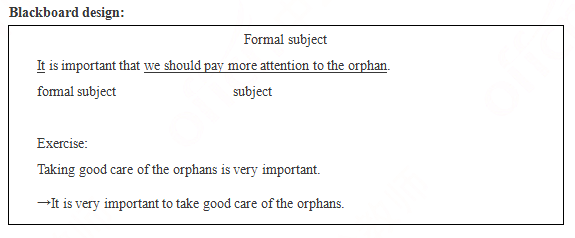
答案:解析:暂无解析 -
第19题:
单选题When the teacher asks students to read a text for the main idea, he/she intends to develop students' skill of _________.Aretelling
Bpredicting
Cskimming
Dscanning
正确答案: C解析: -
第20题:
单选题When the teacher asks students to read a text for the main idea,he/she intends to develop students' skill of_________.Aretelling
Bpredicting
Cskimming
Dscanning
正确答案: A解析: -
第21题:
单选题The teacher gives students 2 minutes to skim a text, and when time is stop and answer some questions. Here the teacher is playing the role of a(an)up, he asks students toAassessor
Bprompter
Cparticipant
Dcontroller
正确答案: D解析: -
第22题:
单选题In a listening class, a teacher asks students to listen to the material carefully and try to discriminate the speaker's attitude towards lifelong learning. What sub-skill of listening is the teacher training?AListening for gist.
BWord Guessing.
CInferring.
DRecognizing communicative signals.
正确答案: D解析: -
第23题:
单选题If a teacher asks students to couect, compace and analyze certain sentence patterns,he/she aims at developing students’ ----.Adiscourse a wareness
Bcultural a wareness
Cstrategic competence
Dlinguistic competence
正确答案: D解析:
